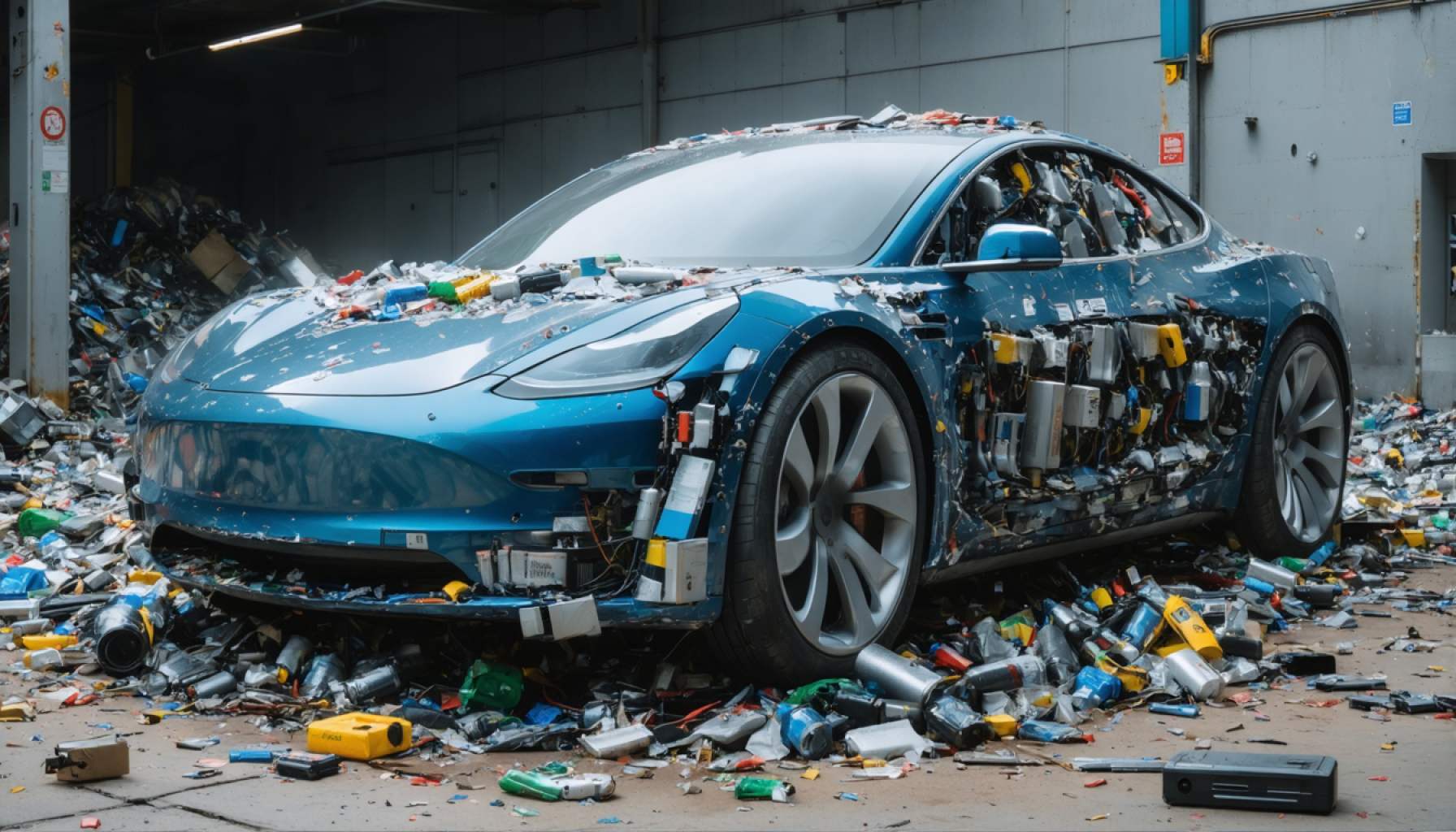
- The EV battery recycling market is projected to grow from $8.6 billion to $50.6 billion by 2031, with a CAGR of 24.8%.
- Recycling enables a sustainable cycle for critical materials like lithium, cobalt, and nickel, reducing waste and preserving resources.
- Key players include GEM Co., Ltd., Eramet, and Redwood Materials Inc., advancing global recycling technologies.
- Eramet and Suez are developing a new recycling plant in France, leveraging advanced technologies, set to open by 2025.
- Rubamin in India aims to process 5,000 tons of battery material annually, with operations starting by mid-2024.
- Breakthroughs from Karlsruhe Institute of Technology claim up to 70% lithium recovery from used batteries.
- Global regions, including North America, Europe, and Asia, offer diverse opportunities for growth and innovation in recycling.
- The industry’s evolution highlights the vital role of recycling in driving sustainability and innovation.
Amidst a backdrop of gleaming possibilities and urgent environmental stewardship, the electric vehicle (EV) battery recycling market surges forward, poised for a transformation both profound and lucrative. With a current market valuation of $8.6 billion, forecasts anticipate an extraordinary ascent to $50.6 billion by 2031, fueled by a robust CAGR of 24.8%.
Imagine a future where the end of a battery’s lifespan marks not a disposal problem but the beginning of a new, sustainable cycle — a vision made manifest through the intricate alchemy of recycling. Vital elements like lithium, cobalt, and nickel, critical to powering the electric future, find themselves reincarnated time and again. This emerging circular economy not only curtails waste but also preserves precious resources, looking to the horizon of innovation with hopeful urgency.
Among the pioneers steering this transformative charge are key players like GEM Co., Ltd., Eramet, and Redwood Materials Inc., each weaving a complex tapestry of opportunity and competition across the globe. In a recent leap forward, French metallurgist Eramet, in concert with Suez, laid the groundwork for a groundbreaking plant employing advanced hydrometallurgical and pyrometallurgical technologies, slated to flicker to life by 2025. Not far behind, Rubamin in India is harnessing technological prowess to craft a recycling hub capable of processing 5,000 tons annually. This facility epitomizes the swift progress into uncharted realms of innovation, expected to open its doors by mid-2024.
In the labyrinthine world of recycling, even the smallest technological advances ripple outward into profound societal gain. German researchers at Karlsruhe Institute of Technology have unveiled a breakthrough method, triumphantly reclaiming up to 70% of lithium from decommissioned batteries, a promising harbinger of the efficiencies yet to come.
Regions across the globe promise diverse landscapes of growth and innovation. In North America, from the bustling hubs of U.S. tech giants to the green initiatives sprouting in Mexico, the stage is set for dramatic evolution. Meanwhile, Europe’s eco-conscious policies and Asia’s industrial might promise fertile grounds for the recycling revolution.
Yet, the tale of EV battery recycling is more than a narrative of growth; it is a testament to the industry’s capacity to adapt, innovate, and lead the charge towards a sustainable future. As we march forward, the real story emerges: a global commitment to repurpose, rejuvenate, and reinvent the very essence of energy consumption. The clarion call is clear — as environmental urgency accelerates, the time to transform potential into kinetic action is not tomorrow, but now.
The profound takeaway is this: as the market forges ahead, the electric spark of ingenuity will illuminate our path to a greener future. Each recycled unit not only represents material recuperation but stands as a testament to the symbiotic relationship between innovation and sustainability. It’s a clarion reminder that even in the smallest particle of a spent battery resides the power to ignite monumental change.
The Future of EV Battery Recycling: Harnessing Green Innovations
Exploring the Dynamics of the EV Battery Recycling Market
The electric vehicle (EV) battery recycling market is on a spectacular journey of growth and innovation. Currently valued at $8.6 billion, this industry is projected to reach an impressive $50.6 billion by 2031, with a compound annual growth rate (CAGR) of 24.8%. This exponential growth is driven by the world’s increasing emphasis on sustainable practices and the rising demand for electric vehicles.
Key Players and Regional Dynamics
Leading companies like GEM Co., Ltd., Eramet, and Redwood Materials Inc. are at the forefront of this transformation. Eramet, in collaboration with Suez, is pioneering advancements with a plant using advanced hydrometallurgical and pyrometallurgical technologies, anticipated to launch by 2025. Rubamin in India is also making significant strides, aiming to process 5,000 tons annually by mid-2024.
Regional Prospects:
– North America: Known for its technological innovation and environmental initiatives, the continent is poised for substantial growth in the EV battery recycling sector.
– Europe: With stringent eco-friendly policies, Europe provides a fertile ground for sustainable practices and industry expansion.
– Asia: Asia’s robust industrial capacity is driving rapid development and innovation in battery recycling technologies.
Technological Innovations and Breakthroughs
German researchers at the Karlsruhe Institute of Technology have made considerable advancements by reclaiming up to 70% of lithium from used batteries. This breakthrough represents the potential efficiencies that can lead to decreased environmental impact and enhanced resource utilization.
Controversies and Limitations
Despite the progress, challenges persist. The recycling process itself can be energy-intensive, raising questions about the carbon footprint involved. There is also the challenge of economically viable processes as technology continues to evolve.
How-To Steps: Enhance Battery Recycling Practices
1. Implement Strong Collection Systems: Establish efficient collection mechanisms for used batteries, ensuring they don’t end up in landfills.
2. Adopt Advanced Recycling Technologies: Invest in cutting-edge technology to maximize resource and energy efficiency.
3. Encourage Policy Support and Collaboration: Advocate for supportive policies and collaborations to streamline industry efforts.
4. Educate and Raise Awareness: Educate consumers about the importance of recycling and how they can contribute to the recycling ecosystem.
Market Forecast and Industry Trends
As EV adoption proliferates globally, the demand for recycling will naturally rise. The industry is expected to witness technological advancements that lower costs and increase the purity of recovered materials. Looking forward, partnerships between private companies, governments, and academia will be critical to addressing technical and economic challenges.
Actionable Recommendations
– For Businesses: Invest in research and development to unearth more efficient recycling methods.
– For Policymakers: Implement regulations that encourage recycling and sustainable practices for end-of-life batteries.
– For Consumers: Participate in recycling programs and stay informed about recycling practices to contribute to environmental sustainability.
As the industry forges ahead, the potential for a greener, more sustainable future is within reach. This revolution is not only about recycling but transforming how we think about resource consumption and environmental responsibility.
For more insights on sustainable practices, visit ABC Sustainability.



